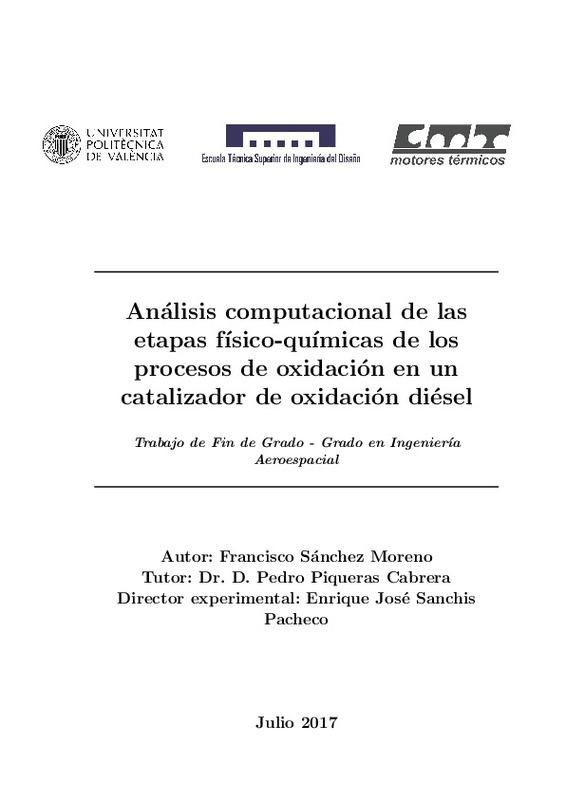|
Resumen:
|
[ES] En los ´ultimos a˜nos ha crecido la preocupaci´on por las emisiones contaminantes y su
efecto en el entorno y la salud p´ublica. Seg´un la Organizaci´on Mundial de la Salud las
emisiones de gases contaminantes es ...[+]
[ES] En los ´ultimos a˜nos ha crecido la preocupaci´on por las emisiones contaminantes y su
efecto en el entorno y la salud p´ublica. Seg´un la Organizaci´on Mundial de la Salud las
emisiones de gases contaminantes es la mayor causa de morbilidad medioambiental y el
n´umero de muertes debidas a la contaminaci´on del aire ha ascendido hasta 8.2 millones.
Para hacer frente a este problema, la mayor´ıa de pa´ıses del mundo, con Estados Unidos
y la Uni´on Europea a la cabeza, han implementado normativas cada vez m´as restrictivas
sobre el nivel de gases y part´ıculas contaminantes emitidas por veh´ıculos, tanto turismos
como de transporte de mercanc´ıas. Estas normas son las llamadas Euro, siendo la Euro 6
la que permanece vigente actualmente.
El cumplimiento de estas normativas ha obligado a los fabricantes a reducir el nivel
de emisiones de sus motores, manteniendo las prestaciones y rendimiento de los mismos.
En este contexto, la utilizaci´on de los sistemas de post-tratamiento de gases de escape
se presenta como una soluci´on tecnol´ogica a este problema. Uno de estos sistemas es el
catalizador de oxidaci´on di´esel o DOC (Diesel Oxidation Catalyst), elemento sobre el cual
gira todo el desarrollo de este trabajo, que se encarga de reducir la concentraci´on de hidrocarburos
y del mon´oxido de carbono en los gases de escape emitidos a la atm´osfera.
El alto nivel de exigencia de las normas actuales y futuras obliga a los sistemas de
post-tratamiento a presentar un alto rendimiento en m´ultiples condiciones de funcionamiento,
exigiendo adem´as que estos sean considerados parte integral del conjunto motor
en lugar de elementos auxiliares. La alta complejidad que demanda la calibraci´on y optimizaci´on
de estos ha hecho necesario el uso de modelos computacionales, los cuales han
de presentar un compromiso aceptable entre precisi´on de resultados y coste computacional.
Para cumplir con esto el Instituto Universitario de Investigaci´on CMT - Motores T´ermicos
ha desarrollado un software llamado VEMOD (Virtual Engine Model). Este es un
c´odigo de bajo coste computacional que se emplea para analizar el comportamiento de un
motor o cualquier elemento del mismo en cualquier punto de funcionamiento. Este software
cuenta con un submodelo de DOC que permite su estudio y ha hecho posible la realizaci´on
de este trabajo, en el cual se ha analizado la influencia que tiene sobre los resultados del
modelo variar la forma en que se resuelve la ecuaci´on de conservaci´on de especies qu´ımicas.
En concreto, se ha estudiado una forma alternativa de considerar los fen´omenos de difusi´on
en la pared porosa del catalizador que permita aumentar la flexibilidad del modelo, as´ı
como la diferencia en el comportamiento de los mecanismos de reacci´on de hidrocarburos
predichos por tres modelos diferentes de reactividad, los cuales son crecientes en grado de
precisi´on y coste computacional.
[-]
[EN] In recent years the concern about pollutant emissions and its effect on the environment
and public health has grown. According to the World Health Organization the emissions
of polluting gases is the major cause of ...[+]
[EN] In recent years the concern about pollutant emissions and its effect on the environment
and public health has grown. According to the World Health Organization the emissions
of polluting gases is the major cause of environmental morbidity and the number of deaths
due to the contamination of the air has increased to 8.2 millions. In order to deal with this
problem, the vast majority of countries, with the United States and the European Union
at the top, have implemented some laws which are increasingly restrictive about the level
of polluting gases and particulates emited by vehicles, both cars and trucks. These rules
are called Euro and Euro 6 is currently in force.
In order to comply with these standards, vehicles manufacturers have been forced to
reduce the engine level of pollutant emissions but keeping their benefits and performance.
In this context, the use of post-treatment systems for exhaust gases and particulates has
became widely spread as a technological solution to this problem. One of these systems is
the Diesel Oxidation Catalyst or DOC which takes care of reducing the concentration of
hydrocarbons and carbon monoxide in the exhaust gas.
The high level of demand of the actual and future standards forces the post-treatment
systems to be very efficient in different operating conditions. This requires to consider
all of these systems as integral part of the engine instead of just auxiliary elements. The
great complexity of calibrating and optimizing these systmes makes essential the use of
computational models which must be balanced in precision of results and computational
cost.
Therefore, the university research insititute CMT - Motores T´ermicos has developed
a software called VEMOD (Virtual Engine Model). This is a low computational cost code
that is used to analyze the behaviour of an engine or any single part of it in any operating
point. This software has a DOC submodel which allows its study and has made possible
the realization of this project. On it has been analyzed the influence on the results that
the model provides the fact of changing the way in which the equation of chemical species
conservation is solved. In particular, in this project has been estudied an alternative way
to consider the diffusion phenomena on the porous wall of the catalyst which makes the
model more flexible as well as the differences in behaviour of the hydrocarbons reaction
mechanisms provided by three different reactivity models. This models are increasingly
precise, changing also its computational cost in the same sense.
[-]
|





![MS Powerpoint file [PP]](/themes/UPV/images/mspowerpoint.png)


